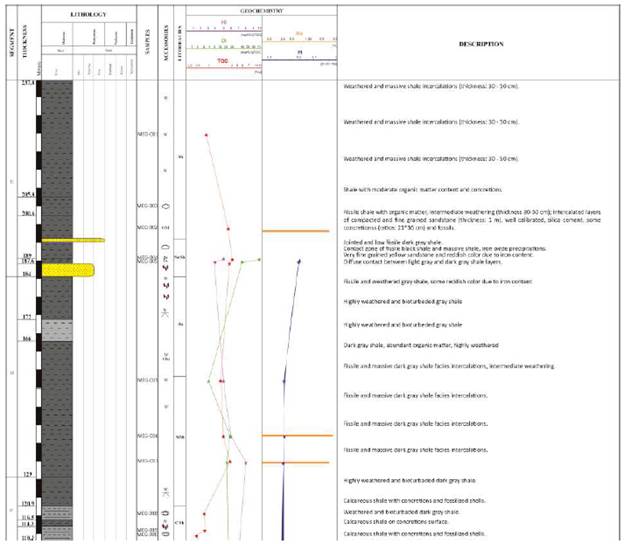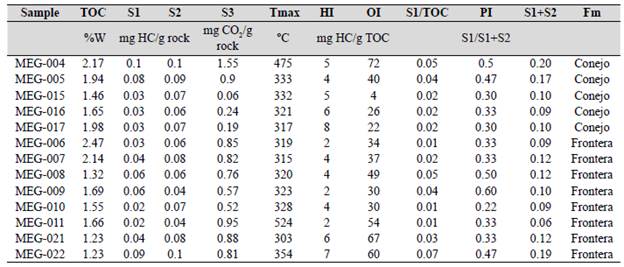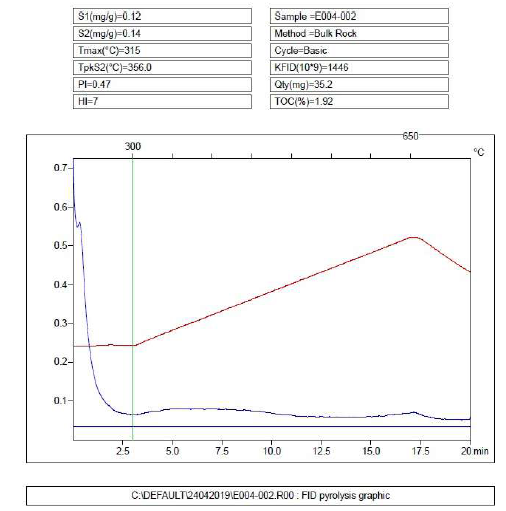Introduction
In unconventional reservoirs, such as gas shales, the gas is produced directly from source rock, the seal is acting not only as the source rock, but also as the reservoir rock and the seal (Hill et al., 2007). Gas shale have become the primary objective of hydrocarbon exploration in the world due to the decrease in the finding of new conventional reservoirs during the last two decades. In Colombia, conventional gas reserves are decreasing, according to data from the Agencia Nacional de Hidrocarburos (ANH), proven gas reserves in Colombia, as of December 2020, were 2,95 Tcf that decreased by 6.7% within the last year. Moreover, shale-gas reserves are unknown and few shale-gas studies in the Eastern Cordillera (Figure 1) have been published. A preliminary estimation of the shale gas potential of the Eastern Cordillera reveals a gas resource of 37 Tcf, calculated based on organic-rich shales, vitrinite reflectance, formation thickness and the size of large structures in the Cordillera (García, 2010). Besides, it has a significant thickness of shales, presence of igneous bodies and salt diapirs; these could be representative components of geological models for unconventional deposits (Guiza and Vargas, 2016).
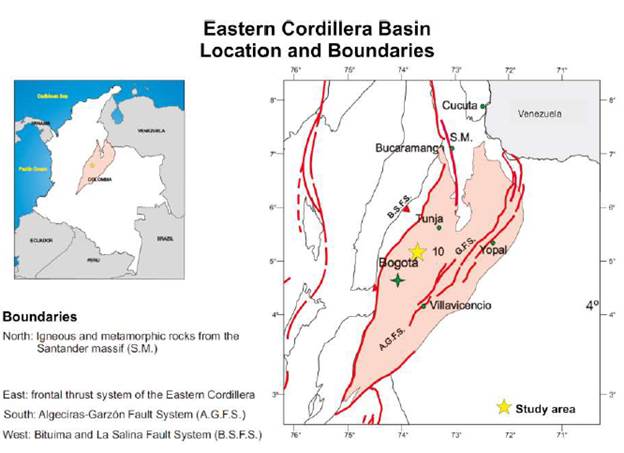
Figure 1 Location and boundaries of Eastern Cordillera Basin, Colombia (adapted from Barrero et al., 2007).
In this study we analyzed outcrop samples from La Frontera and Conejo Formations (Cenomanian - Santonian) along Alto de los Caballeros section (Figure 2), in the western flank of the Eastern Cordillera; this flank presents calcareous facies, the best organic matter content and vitrinite reflectance conditions, compared with east flank and central zone (Moreno, 2010). Geochemical and petrographic analysis were carried out to determine if La Frontera and Conejo Formations can be classified as a gas shale reservoir in the Chécua-Lenguazaque Syncline (Figure 2); this structure corresponds to a place in the subsurface where the source rock would have reached the appropriate pressure and temperature conditions to generate hydrocarbons (Tarazona, 2017), in addition to geochemical conditions (Rezaee and Rothwell, 2015): Total Organic Carbon (TOC)>2%, organic matter thermal maturity from vitrinite reflectance (%Ro) greater than 1.5%, percentage of fragile mineral content such as carbonate (CaCO3) and quartz (Qz) greater than 50%, and clay content less than 50%.
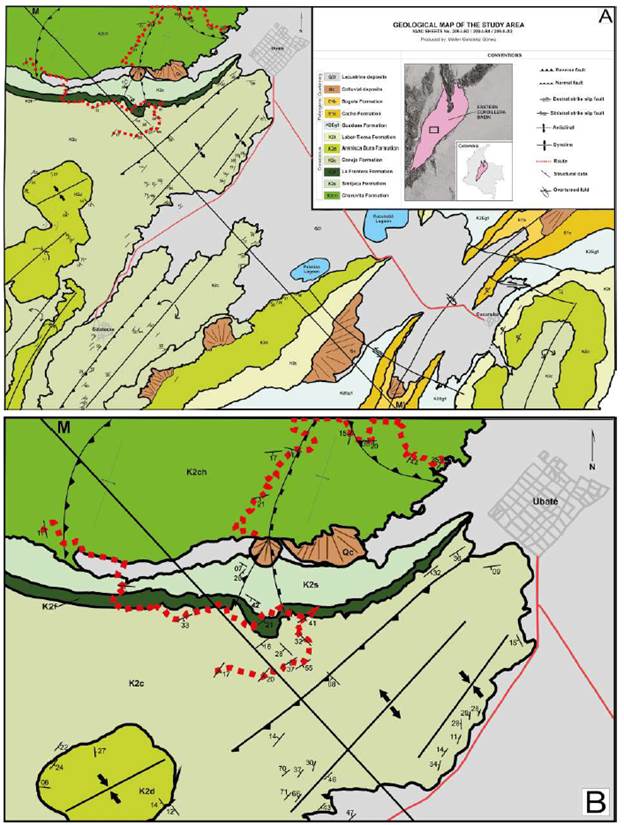
Figure 2 Geological map of study area. A. This geologic map is the result of a field work in cooperation with undergraduate geology students registered in the Field I work course of 2018 at the School of Geology at the Universidad Industrial de Santander, Colombia. B. Zoom of the interest area.
The purpose of this work was to provide new geochemical and petrographic data for the preliminary evaluation, as a gas shale reservoir, of La Frontera and Conejo Formations in the Eastern Cordillera in Colombia.
Methodology
A total of seven (7) thin sections corresponding to La Frontera Formation were processed and classified according to Folk (1974). For each sample, thin sections impregnated with epoxy resin, stained in standard blue, complete carbonate staining and potassium feldspar were prepared to analyze the main types of grain, total visual porosity, carbonate, quartz, clay, fossils or any other mineral content evident in the thin sections. This analysis was carried out using an optical advance trinocular petrographic microscope with a 16 MP Axiocam digital camera coupled.
The TOC analysis for combustion was developed according to Jarvie (1991), for this analysis was used a carbon and sulfur analyzer equipment with high temperature furnace and non-dispersive infrared detection, DNIR LECO SC-144DR, using the parameters: combustion furnace temperature 1350.30°C, high purity oxygen as oxidation gas, and infrared cell oven temperature 48.28°C.
The Rock Eval pyrolysis was developed according to Peters (1986), to the estimation and prospecting of hydrocarbons from pyrolysis and combustion in a rock sample, it was used an equipment with detection of flame ionization (FID), and selective infrared (CO and CO2) in real time: Rock Eval Turbo 6, Bulk Rock method, basic cycle, final temperature of the pyrolysis furnace 650°C and final oxidation furnace temperature 850°C.
The thermal maturity was evaluated by °%Ro according to Peters et al. (2016), for this analysis was used a triocular microscope Carl Zeiss Imager Z1. All the geochemical analyzes were carried out into the Laboratorio de Geoquímica del Petróleo at the Universidad Industrial de Santander, Guatiguará campus.
Results
Stratigraphy
The stratigraphy of the area, compiled in the Geología de la Plancha 209 - Zipaquirá by Montoya and Reyes (2003), expresses that the Upper Cretaceous in the study area include from the Cenomanian to the Santonian. A stratigraphic column was measured and described along the Alto de los Caballeros section, where La Frontera and Conejo Formations outcrops.
La Frontera Formation (K2f): The segment A (Figure 3) is highly consolidated by layers of up to 1.5 m of fossiliferous limestones (micrite) with tabular geometry. Calcareous-ellipsoid concretions and some intercalation of fissile and clay shale were observed, while the microfossil content consisted in calcite-filled foraminiferous (Figure 4A). This section is particularly important because it exhibits good organic matter content and maturity conditions for gas shale. The segment B (Figure 3), at the top of the sequence, is characterized by its fissile and weathered shale with medium to dark gray color.
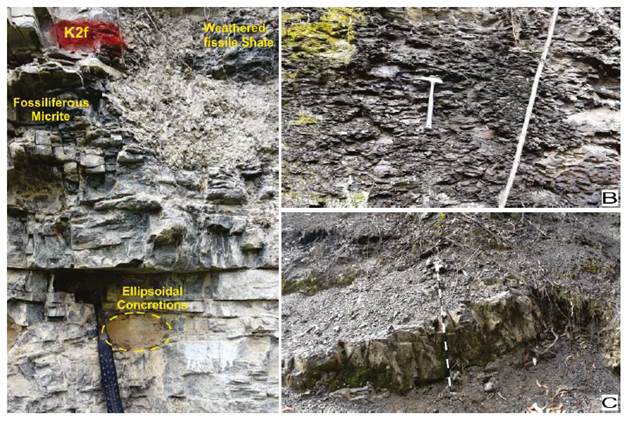
Figure 4 La Frontera and Conejo Formations. A. La Frontera Formation segment A: These differentiated layers shows a high hardness degree and compaction with silicon matrix, variations in organic matter content, from moderate in its base to high in the upper part of segment. B. Conejo Formation segment A: Dark gray to black shale layers; abundant organic matter content and high weathering degree due to water filtrations in the outcrop. C. Conejo Formation segment D: Dark gray fissile shale layers altered by weathering, plus massive shales up to 70 cm.
Conejo Formation (K2c): The thickness at the Alto de los Caballeros section is 237.8 m, divided in 5 segments. Segment A: with 55 m measured thickness, it has a dark gray color, very fissile structure, abundant organic matter content and a high degree of weathering due to water infiltration (Figure 4B). Segment B: it presents tabular layers of gray shales rich in organic matter, also bioturbation. Segment C (Figure 5): it shows a dark gray, moderate fissile and highly weathered shale, including concretions and fossilized shells, besides, high-grade oxidation process and ellipsoidal concretions formed by iron oxide. Segment D (Figure 5): massive intercalation of shale facies (55 m), in tabular layers up to 70 cm thick, between layers of fissile and highly-weathered shale, affected by oxidation and bioturbation (Figure 4C). Segment E (Figure 5): fine grained sandstone that exhibits moderate organic matter content and reddish color due to the precipitation of iron oxide, plus thin shale layers about 30 to 50 cm, affected by bioturbation towards the top.
Facies Interpretation
According to Miall (1990), the word facies has a descriptive and interpretative meaning. The descriptive meaning includes lithofacies and biofacies. Lithofacies is a rock unit defined according to its distinctive lithological characteristics including composition, grain size, stratification, and sedimentary structures; that is the meaning of lithofacies used in this paper; and the purpose is to identify stratigraphie segments showing relevant petrographic features to the characterization of the shale gas plays. Thus, for each lithofacies, it was used a naming system that includes a descriptive letter, indicating the main features of the lithological unit (type of predominant lithology), and the main characteristic of the rock body, as follows: Fossiliferous micrite (FM), Siliceous shale (SiSh), Calcareous shale (CSh), Organic shale (Sh), Sandstone shale (SstSh - shale with sandstone predominance).
Lithofacies at La Frontera Formation
Fossiliferous Micrite (FM): corresponds to segment A, this is a calcareous-muddy matrix (60-80%) laminated and microcrystalline, medium gray color, compact, massive, conchoidal fracture, in tabular strata. In addition single serial microfossils content associated to deep platform environment; filled with non-ferrous calcite (10-40%), low microporosity (1-2%) due to calcite dissolution, also moderate to high organic matter content.
Siliceous shale (Sish): corresponds to segment B and part of the segment C; this is a dark gray color shale, compact, massive, conchoidal fracture, in tabular strata with minor intercalation of fissile shale, good organic matter content, and occasional pyrite nodes.
Lithofacies at the Conejo Formation
Siliceous shale (Sish): corresponds to the segment B and part of the segment C, this is a dark gray massive shale with conchoidal fracture, in tabular strata and few fissile shale layers, good organic matter content, and occasional pyrite nodules.
Sandstone shale (Sst/sh) (sandstone 80-90%, shale 10-20%): this very fine grain sandstone rich in quartz corresponds to segment E, moderately reddish color due to iron oxide. Besides, fissile shale intercalations, medium to dark gray color, moderate organic matter content rocks affected by bioturbation.
Calcareous shale (Csh) (shale 80-90%, limestone 10-20%): this is a calcareous-massive shale, with concretions and fossilized shells, plus fissile shales intercalations, medium gray color that occasionally turns yellowish due to weathering and bioturbation; deposited in a low - energy environment, under favorable conditions for carbonate precipitation, away from the shoreline, in the open ocean platform.
Organic shale (Sh): it embraces a great area of Conejo Formation at the Alto de los Caballeros section. Exhibiting medium to dark gray fissile shale layers with organic matter content, affected by weathering and bioturbation. It is associated to an open platform sedimentation environment.
Organic Geochemistry
The following parameters were analyzed in the samples taken from La Frontera and Conejo Formations: TOC to determine the amount of organic matter; Maximum Temperature (Tmax) and °%Ro to determine the organic matter thermal maturity; and finally, the Hydrogen Index (HI) to define the organic matter type or quality in the analyzed samples. The analysis of these parameters leads to the evaluation of the hydrocarbon production capacity.
Total Organic Carbon Analysis and Rock Eval Pyrolysis
The Table 1 shows the results for both, TOC and pyrolysis for La Frontera and Conejo Formations. Rock Eval pyrolysis results indicates HI <50 mg HC/gTOC, associated to a S2/S3 ratio <1. The S1 and S2 values less than 0.5 and 0.25 mg HC/g rock respectively, indicates poor hydrocarbon production potential (Peters and Cassa, 1994).
For the S3 peak the values vary between 0.06 to 1.55 mg CO2/g of rock. S3 peak corresponds to the CO2 generated by decomposition of organic matter (Jiang et al., 2017), and their high values are related to the CO2 recorded during pyrolysis stage, in the measurement of its organic origin (S1 peak) and its mineral origin (S3' peak) according to Behar et al. (2001). These samples could also be exposed to alterations because were extracted from outcrops and not from cores, therefore they could be weathered. Another possibility is that this is the actual amount of carbonate in the limestones of La Frontera Formation.
Both formations show very low S2 data, associated to values lower than 0.2 mg HC/g TOC, while Tmax was below 435°C which is considered immature for hydrocarbon producing rocks. According to Peters (1986), Tmax values associated to peaks of S2<0.2 mg HC/gTOC are inaccurate and not reliable because the Tmax can be affected by factors like maturity, organic matter type, contamination and mineral matrix.
Vitrinite Reflectance Analysis
During the vitrinite reflectance analysis was possible to obtain %Ro readings from three samples: MEG-002, MEG-016 (Figure 6A), and MEG-017 (Figure 6B) of the Conejo Formation at the Alto de los Caballeros section with average %Ro values of: 2.5, 2.8, and 2.5 respectively (Table 2). Additionally, based on secondary information, a %Ro value of 1.63 was obtained for La Frontera Formation at the Alto de los Caballeros sector (Hernández and Sanabria, 1999 in Uribe and Sánchez, 2019). However, there was a very low amount of vitrinite reflectance readings in these samples (Table 2), considering that the organic matter of these formations comes from a marine environment, where low amounts of vitrinites are the result of the limited contribution of land organic matter (Peters and Cassa, 1994).
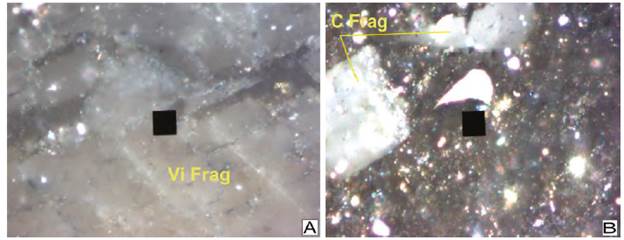
Figure 6 Organic petrography analysis Conejo Formation. A. Vitrinite fragment (Vi Frag) from MEG-016 sample. B. Carbonate fragment (C Frag) from MEG-017.
The Tmax values obtained by Rock Eval pyrolysis are not reliable (Figure 7) because the low value of the S2 peak (Peters 1986; Carvajal-Ortiz and Gentzis, 2015). The maturity values obtained by the vitrinite reflectance analysis and the secondary information are coherent, both indicate the overmature state of La Frontera and Conejo Formations, this implies that these formations have attained the maximum degree of transformation and generation according to the production index parameter (PI>0.4).
Petrography
Seven thin sections in La Frontera Formation were analyzed and described according to Folk (1974) classification system. This corresponds to the samples MEG-009 (Figure 8), MEG-010, MEG-013, MEG- 021 and MEG-022 (Figure 9), MEG-023 and MEG- 024 (Figure 10). These samples were classified as fossiliferous limestone (micrite) with high organic matter content at the top of the sequence, moderate toward the intermediate zone, and low content at the base of the formation. In general terms, a laminated-matrix micrite (60-80%), with microfossils (34%) were observed mainly composed by a single-series foraminifera filled with non-ferrous calcite. The microporosity value was around 2%.
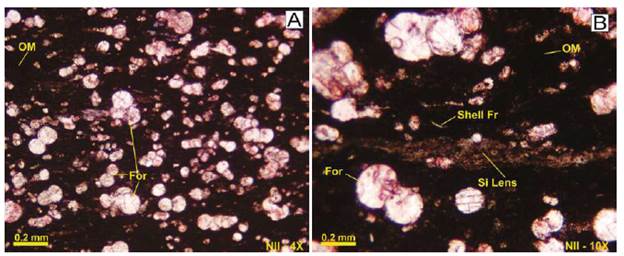
Figure 8 Sample MEG-009. A. Dispersed organic matter (OM) in argillaceous matrix. B. Silicon lens (Si Lens), Uniserial foraminifera (For), and shell fragments (Shell Fr). Photo by: Jorge Meza / José Trespalacios.
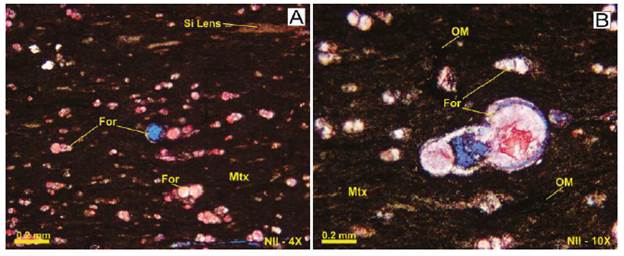
Figure 9 Sample MEG-022. A. Fossiliferous mielite with organic matter widely dispersed in the same lamination direction, silicon lens (Si Lens), uniserial foraminifera (For) and matrix (Mtx). B. Detail of an uniserial foraminifera (For) with replacement of silica by calcite, micrite matrix (Mtx) and moderate organic matter content (OM). Photo by: Jorge Meza / José Trespalacios.
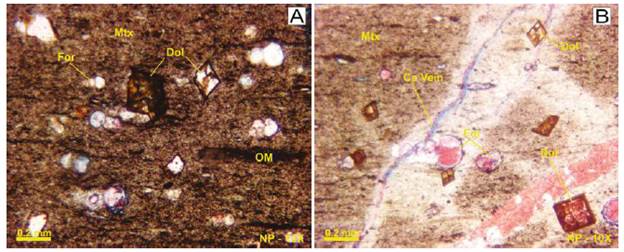
Figure 10 Sample MEG-024. A. Micrite matrix (Mtx), uniserial foraminifera (For) and rhombohedral crystals of oxidated dolomite (Dol). B. Calcite vein (Ca Vein), uniserial linear foraminifera (For), matrix (Mtx), moderate organic matter content (OM), oxidated dolomite rhombohedral crystals (Dol). Photo by: Jorge Meza / José Trespalacios.
The samples of La Frontera Formation correspond to fossiliferous limestone (micrite), these rocks, with abundant quartz content, results in a high-grade of hardness and therefore an increased susceptibility to hydraulic fracture. There is no evidence of clay minerals, and the carbonate content is associated with the non-ferrous calcites found inside the uniserial foraminifera microfossils, whose content increases as it approaches to the top (39%) than toward the base (3-10%). On the other hand, a high organic matter content decreases gradually from the top to the base as follows: high at the top, high-moderate to moderate at the intermediate level and low at the bottom layers.
Discussion
After analyzing the stratigraphic column (Figure 3) it was found that the limestone levels at La Frontera Formation shows a very high content of organic matter. There is also an important content of shale, but these are severely affected by weathering and oxidation present in the area. Besides, the TOC analysis shows there is an increment of this parameter toward the top of the Conejo Formation at the Alto de los Caballeros section, particularly in the segments D and E, where the organic matter content increase from good to very good.
With reference to the Rock Eval pyrolysis results, the Tmax obtained are not reliable because they are associated to a low peak of S2<0.2 mg HC/gTOC (Peters and Cassa, 1994). This situation could have two possible explanations: The first is associated to the quality of the samples, which in this work comes from outcrops. According to Peters and Cassa, (1994), the rock sample quality decreases in the following order: core samples, sidewall core, drilling cuttings, and outcrop samples. This is explained because outcrop samples are exposed to weathering and/or oxidation. The second explanation is related to the fact that Tmax is the temperature registered when reaching the S2 peak; however, if there is an alteration or deformation of this peak, the Tmax value is also affected, because the pyrolysis equipment assigns the Tmax value to any stable point in the slope of the curve without considering its shape.
Therefore, the thermal maturity value at La Frontera and Conejo Formations was determined based on the production index (PI>0.4) and the vitrinite reflectance analysis, these results reveal an overmature state (%Ro>1.35) of these formations, thus indicate that they are within gas generation window. The %Ro analysis also identified a very low content of vitrinite in the samples, probably due to a limited contribution of terrestrial organic matter. On the other hand, high values of vitrinite can be the result of oxidized vitrinites (Peters and Cassa, 1994).
All the above-mentioned parameters, TOC, %Ro, Qz and CaCO3 content are fundamental for the characterization of a non-conventional reservoir. In addition, factors such as the Transformation Rate (TR) equivalent to PI, net formation thickness, shale percentage mineralogy and total porosity, can be analyzed in a polar graph to compare the quality of each parameter. The Figure 11A shows five evaluation criteria: The most external zone (illustrated with light gray color) shows the reservoirs with the best characteristic, while the most internal zone (illustrated with dark gray color) shows the reservoir with the lowest quality. La Frontera (blue line) and Conejo (red line) Formations show good properties and are classified with highly-converted shale gas system with a high-potential flow index; this confirms that both formations have layers where the characteristics can be classified as suitable for a non-conventional reservoir. Both formations show different behavior, being the CaCO3+Qz content slightly better in La Frontera Formation than in the Conejo Formation, while the PI is similar for both. Although the total carbonate content in the Conejo Formation differs a little from ideal, the low quality of one factor can be compensated by the good quality of another one. For instance, low carbonate content can be compensated with a greater content of quartz; being this a factor that also affects rock fragility. In the Figure 11B are represented two points of reference, where successful shale gas reservoirs in the United States (Barnett and Lewis shale) show quality differences in the reference parameters, the reservoir in both cases have been successfully exploded. Usually, there is a successful world-famous example, of shale gas reservoir, outside of the ideal limits criteria. Nevertheless, the most suitable candidates must fulfill other rigorous characteristics such as elastic properties, pore pressure, and water saturation between others (Askenazi et al., 2013) to be completely characterized. All these conditions have not been yet evaluated in the study area in order to determine the feasibility of a project.
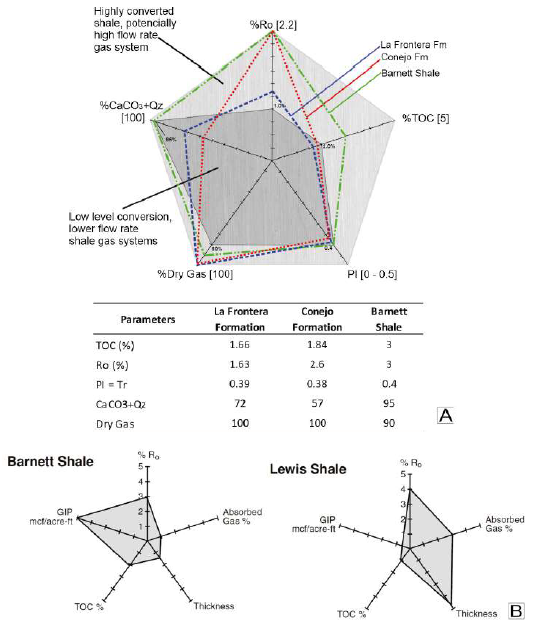
Figure 11 A. Graph comparing the parameters for the shale gas 1 system (modified from Jarvie, 1991). B. Parameter comparison for shale gas systems for two successful unconventional reservoirs in the United States, Barnett Shale at left and Lewis Shale at right (Curtis, 2002).
Conclusions
In brief, the geochemical, stratigraphical, and petrographic characteristics of La Frontera and Conejo Formations, evidenced that there are levels that effectively acomplish the geochemical characteristics to be classified as a potential unconventional reservoir; these parameters were evaluated on surface, and, according to the geological map, they are located deep in the Chécua-Lenguazaque Syncline, where the stratigraphic sequence cover the structure.
In the case of shale gas, the best conditions were found in La Frontera Formation, segment A, at Alto de los Caballeros section, associated to fossiliferous-micrite lithofacies. This segment shows organic matter content between 1.23% at the base, that increases to reach 2.47% at the top of the segment, therefore, in an overmature state. The quartz content is over 50%, the microporosity is between 1-2%, and thickness of 8.8 m. This zone, located at the base of the formation shows a high degree of hardness, and as a result, an increase in the rock fracture susceptibility. Furthermore, after comparing international evaluation criteria to qualify unconventional reservoirs, the characteristics of La Frontera Formation shows that this formation represent the better geochemical parameter qualities required to be preliminary classified as a gas shale reservoir.
On the other hand, the Conejo Formation, has significant thickness of dark gray to black shales, with a high-grade fissility, but, in the segment C, this formation has some levels with calcareous content and high-grade of hardness; these massive calcareous shale levels could also be classified with potential shale gas reservoir. Of course, the data presented here is not conclusive, and it is necessary to complement this research with additional studies.















